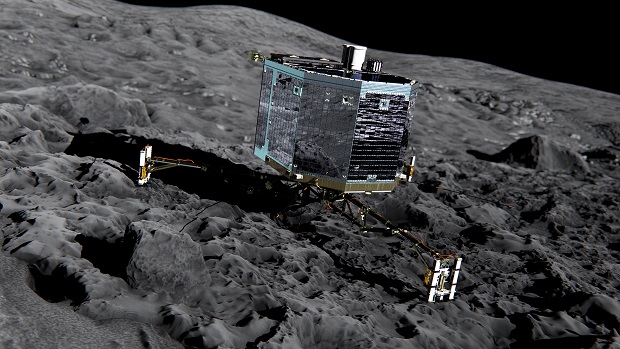Man has achieved another first last year by successfully sending a spaceship to a comet. Last November, Rosetta reached 67P/Churyumov-Gerasimenko and began orbiting the comet while its probe, Philae, landed on the comet’s icy surface.
Although Rosetta is successfully orbiting the comet, the probe on the surface only managed to work for around 60 hours because its batteries died. Equipped with solar panels, the probe was supposed to get energy from the sun but because it landed with a bounce and ended up in a location shadowed by a cliff, it was not able to recharge its batteries.

Publicly provided by the European Space Agency, ESA
Photo credit: ESA/ATG medialab/ESA via AP
The spacecraft was forced to hibernate but scientists were positive its mission has not failed as they hoped Philae would be able to gather energy as the comet nears the sun. This proved to be an excellent hypothesis as Philae sent signals at around 10:28 p.m. (2028 GMT; 4:28 p.m. EDT) on Saturday, reports the Inquirer.
After transmitting system and housekeeping data for around 85 seconds, the probe once again went on hibernation but scientists were positive that the spacecraft will be sending more data soon. Based on data transmitted, the probe appears to have been awake for days and was probably conserving energy to be able to send data.
With the comet approaching the sun in the coming weeks, more data are expected to come in. German Aerospace Center project manager Stephan Ulamec revealed they are excited with this latest update. Though they had expected this to happen, it was still exciting to have received such news in the middle of the night, he said.
The probe’s exact location on the comet’s surface is yet unknown but scientists are hoping they would be able to pinpoint where this washing machine-sized spacecraft landed so they could execute commands to make sure that Rosetta, the mother ship, will be closer to the lander so that communication links will be stronger and Philae will be able to send out more data to Earth.

Photo credit: CNN
The comet will be closest to the sun on August 13 but Philae might just be able to obtain enough energy to last until October 2015. Scientists are hopeful Philae would once again wake up from hibernation the next time the comet nears the sun but it is highly likely it will be hibernating forever.





